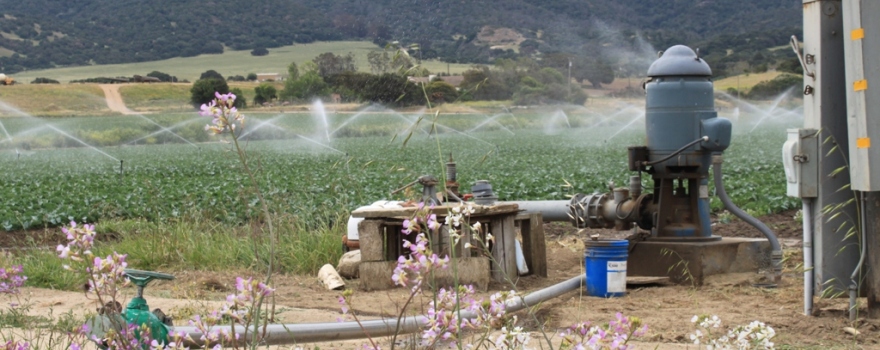Survey of groundwater professionals points to need for standardized data monitoring and makes policy recommendations for successful implementation of historic groundwater legislation.
From the Stanford News Service:
After decades of dysfunction that have exacerbated chronic water problems, historic groundwater legislation has brought California to the cusp of a new era of water management. Meeting the law’s goals, however, will require overcoming stubborn systemic obstacles, according to a report by researchers at Stanford’s Water in the West program and the Gould Center for Conflict Resolution at the Stanford Law School.
Water pumped from underground aquifers supports farm irrigation systems in Central California and elsewhere around the state. A new Stanford study recommends how to make this water use sustainable.
The statewide survey of groundwater professionals found a range of shortcomings in groundwater data collection and use. The report also outlines regulatory and policy actions that could improve data collection and coordination, vastly improving how California handles the source of up to 60 percent of its water supply.
“Like a bank account, managing groundwater effectively requires understanding what comes into the system and what goes out,” said lead author Tara Moran, sustainable groundwater program lead at Water in the West, a joint program of the Bill Lane Center for the American West and the Stanford Woods Institute for the Environment. “That’s been impossible on a statewide level in California and even on the level of groundwater basins, which are usually managed by multiple agencies that are not required to share information.”The Sustainable Groundwater Management Act (SGMA), passed in 2014, requires sustainable management and takes important steps toward ensuring more effective collection and integration of groundwater data. It also calls for the monitoring of groundwater basins, permeable areas that drain large amounts of water to natural underground storage areas. But the law stops short of requiring local agencies to adopt statewide monitoring protocols, instead allowing flexibility to determine the monitoring activities that best meet their needs. Yet, standardized monitoring would make groundwater information more shareable across regions and the state.
Uncoordinated and inconsistent data collection among California’s more than 2,000 local and state agencies involved in groundwater management is one of the factors contributing to poor groundwater management in the state. This has led to massive drops in groundwater levels, dry domestic wells, land subsidence – the gradual sinking of land – of more than one foot per year in some locations, ecosystem die-outs and reduced stream flows.
The survey finds, among other things, that many local agencies do not have dedicated groundwater-monitoring wells and many data necessary for sustainable groundwater management are missing or are highly uncertain. Twelve percent of respondents with established groundwater monitoring networks do not have a singe dedicated monitoring well. Up to 38 percent of respondents indicated a high degree of uncertainty about groundwater recharge potential, sustainable yield estimates, groundwater recharge locations and groundwater-dependent ecosystems.
Based on their findings, Moran and her colleagues suggest regulatory and policy changes for local, state and federal groundwater management agencies. Among them: use the authority under SGMA to monitor private production wells and to implement groundwater extraction metering; and develop a statewide advisory committee to provide guidance on new data collection technologies and other data-related topics.
“Achieving SGMA’s goal of sustainably managed groundwater basins will require building a shared understanding of groundwater conditions across a diverse range of interested parties,” said co-author Janet Martinez, director of the Gould Center. “This survey provides us with critical insights on the data management efforts needed to accomplish this.”
The researchers plan to release more detailed survey analysis in a series of reports and academic publications that combine survey results with key findings from an ongoing four-part groundwater data workshop series at Stanford.
Click here for summary notes from the first two workshops – on groundwater models and groundwater data.
Co-authors of “From the Ground Down: Understanding the Groundwater Data Collection, Adequacy and Sharing Practices of Local Groundwater Management Agencies in California” also include Amanda Cravens, collaborative technology specialist and researcher at the U.S. Geological Society; and Leon Szeptycki, executive director of Water in the West and Stanford Woods Institute professor of the practice.
Funding for the report was provided by the S.D. Bechtel Jr. Foundation.
 Sign up for daily email service and you’ll never miss a post!
Sign up for daily email service and you’ll never miss a post!
Sign up for daily emails and get all the Notebook’s aggregated and original water news content delivered to your email box by 9AM. Breaking news alerts, too. Sign me up!


